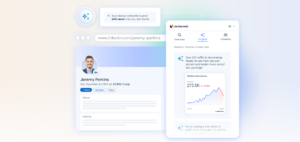Written by Elizabeth Anderson, Interim CEO of the DPA
In an increasingly digital world, access to the internet and digital technology has become essential for participation in modern society. However, the recent report released by Deloitte and the Digital Poverty Alliance highlights that between 13-16 million of those aged over 16 find themselves on the wrong side of the digital divide, grappling with the challenges digital poverty presents.
This issue has to be of paramount concern, with the report revealing that one in two older people face digital poverty, while younger adults are also more likely to be affected than middle-aged adults.
Digital poverty sees negative results for those who are impacted by being offline. For older individuals, this often means being left behind in a rapidly evolving digital landscape. In a world where essential services, information, and social connections increasingly can only be found online, older people without digital access can find themselves isolated. This can have all sorts of impacts for the the 25 per cent of older adults (65-75 years old) with no internet access at home – from struggling to access online based ticketing for trains, to being unable to access healthcare information.
Conversely, younger adults’ digital exclusion can hinder their educational and employment opportunities. An estimated 1 in 5 children are impacted by digital poverty and in an era where remote learning and digital skills are crucial – especially when accessing homework set exclusively online, those without access to technology face a substantial disadvantage.
The digital divide cuts across generational lines, economic strata, and geographical regions. It is not simply a matter of convenience; it is a matter of equity, equal access to opportunities, and social inclusion.
Addressing this issue requires concerted efforts from governments, policymakers, industry and communities to bridge the digital divide, ensuring that no one is left behind in an increasingly digital world.
Failure to do so risks exacerbating existing inequalities and leaving a significant portion of the population disenfranchised.
The domino effect
Digital poverty appears to be a vicious circle, one that affects various aspects of individuals’ lives and communities.
At its core, digital poverty exacerbates unemployment and hinders access to economic opportunities. Those who are unemployed are 2 to 3 times more likely to experience digital poverty compared to the employed population and 5-7 times more likely to lack essential digital skills.
In an age where 90 per cent of jobs are only posted online and require digital applications, this cuts many from accessing fulfilling employment. When individuals lack the digital access necessary for job searching, online applications, and virtual interviews, their chances of finding employment decline. As a result, they remain trapped in unemployment or underemployment.
Digital poverty also results in the inability to access online resources, including education, healthcare, and government services. This exclusion not only restricts access to essential services but also deepens the social and economic divides within society.
Simultaneously, digital poverty contributes to the growing digital skills crisis faced by employers. The rapid advancement of technology demands a workforce with digital proficiency, and the divide between those with access to technology and those without exacerbates this crisis. Employers are left struggling to find qualified candidates, leading to labour shortages in certain sectors, hampering economic growth, while stifling innovation.
In essence, the domino effect of digital poverty creates a complex and interrelated set of challenges. Effective policies and initiatives are needed to break this cycle and ensure that everyone has equal opportunities to participate in the digital age
Solving Digital Poverty
Solving digital poverty is not just a moral imperative; it is a pathway to unlocking a multitude of benefits for individuals, businesses, and the economy as a whole.
The report’s outlined objectives present a compelling case for addressing this issue comprehensively, as it has the potential to yield wide-reaching advantages, including the substantial reduction of unemployment by an estimated 46,000 to 56,000 individuals each year.
At the individual level, bridging the digital divide means providing equal opportunities for all. When people have access to digital technology and the skills to use it, they can actively engage in the modern world. Additionally, digital access allows individuals to access telehealth services, online government resources, and various e-commerce platforms, enhancing their quality of life and convenience.
For businesses, solving digital poverty translates into a broader pool of skilled job seekers. As more individuals gain access to digital tools and resources, they can upskill and contribute to a more technologically adept workforce. This, in turn, fosters innovation and increases competitiveness in the global market.
From an economic perspective, addressing digital poverty can have a profound impact. The reduction in unemployment by tens of thousands each year not only alleviates the burden on social welfare systems but also contributes to increased tax revenue and economic growth.
By narrowing the digital divide, society can foster a culture of inclusion and equality while simultaneously driving innovation and growth. Digital access plays a crucial role in an individuals’ ability to participate equally in society and the benefits of digital inclusion extended far beyond equal opportunity, driving positive change which will support businesses, government and society as a whole.









